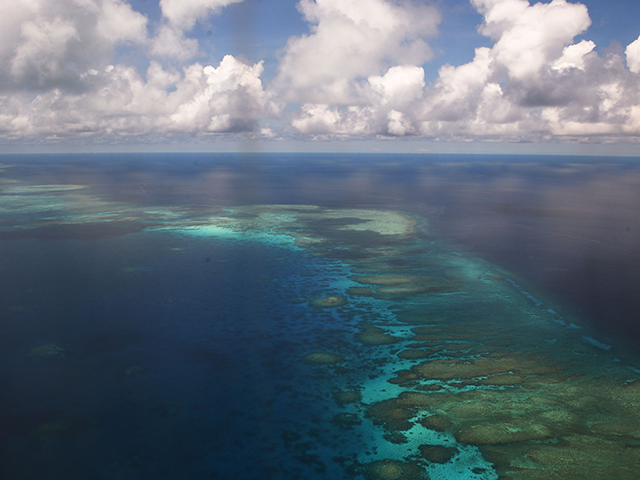Bloomberg News on Wednesday quoted a group of Western officials who accused China of creating more artificial islands in the South China Sea, specifically in the disputed Spratly archipelago, in what looks like the first stage of an audacious new land grab.
“While China has previously built out disputed reefs, islands and land formations in the area that it had long controlled — and militarized them with ports, runways and other infrastructure — the officials presented images of what they called the first known instances of a nation doing so on territory it doesn’t already occupy,” Bloomberg’s sources explained.
China’s colonization process involves dredging up sand and rock to enhance minimal “features” such as tiny reefs and desolate sand bars until they become large enough to support military structures.
China is building up several unoccupied land features in the South China Sea, according to Western officials, an unprecedented move they say is part of Beijing’s effort to strengthen claims to disputed territory. https://t.co/JilMEontuc
— The Japan Times (@japantimes) December 21, 2022
China then builds military infrastructure with gusto, covering its artificial islands with everything from radar installations and missile launchers to bomber-capable runways. Once a sand bar has been transformed into a sort of stationary aircraft carrier, bristling with missiles and warplanes, the question of which government actually owns the waters around that islet becomes moot.
In the case of the Spratlys — claimed by Taiwan, Vietnam, the Philippines, Malaysia, and Brunei in addition to China — the new twist is that Beijing did not even bother making a specific claim on the features under development. They just sent in “fishing fleets that operate as de facto maritime militias” to begin enhancing land formations at Eldad Reef, Lankiam Cay, Whitsun Reef, and Sandy Cay.
Philippine military photos caught a Chinese “fishing militia” ship dropping an amphibious excavator on Eldad Reef in 2014. The reef, which used to be largely submerged, is now permanently above the high-tide line and is covered by clearly visible excavator tracks. Whitsun Reef and Sandy Cay are also over the tide line now, and Lankiam Cay sports a perimeter wall.
The Philippine government further complained that Chinese “fishing vessels” are swarming around Iroquis Reef and Sabina Shoal, an intimidation tactic China uses to chase away Filipino fishermen who have long worked in the area.
China and Vietnam Pick Up Island-Building Activity in S. China Sea https://t.co/EsUmJsM1Zz pic.twitter.com/LZxGmBoxhg
— TheEazyCadet (@EazyCadet) December 21, 2022
None of these developments are particularly subtle, but the Chinese Foreign Ministry still dismissed Philippine reports on China’s island reclamation projects as “purely made out of thin air.”
The Philippine government noted China’s activities directly contradict multilateral agreements the Chinese government made with Southeast Asian nations to avoid this type of territorial aggression in disputed waters, not to mention the landmark 2015 international court ruling that categorically rejected China’s claim to own 80 percent of the South China Sea region, a decision Beijing routinely ignores.
https://www.businessinsider.com/no-nine-dash-line-in-the-south-china-sea-2016-7
As Bloomberg noted, China’s aggressive actions in the Spratlys have major regional security implications. The other claimants fear the precedent that would be set by China simply developing and militarizing every island it wants until competing claims become historical footnotes, while the international community worries that China could use bases in the Spratlys to threaten major international shipping lines. There are also some valuable undersea oil and gas deposits at stake.
The Philippine government has primarily responded to China’s aggression by lodging formal complaints, while Vietnam is working on its own island reclamation projects to solidify its foothold in the Spratlys. Vietnam’s accelerating land reclamation project is much smaller than China’s, but still managed to add about 420 acres of new island ground in the past six months, a 300-percent increase over Vietnamese island-building activity over the previous ten years.
“Vietnam’s dredging and landfill activities in 2022 are substantial and signal an intent to significantly fortify its occupied features in the Spratlys. These expansions are ongoing and what infrastructure the expanded outposts will host remains to be seen,” said the Asia Maritime Transparency Initiative (AMTI) at the Center for Strategic and International Studies.
AMTI noted Vietnam has developed two features, Namyit Island and Pearson Reef, until they are larger than the chain-naming Spratly Island itself. Both features are now large enough to begin construction on dredged ports that can handle large vessels. Vietnam is additionally expanding five other Spratly features that previously hosted only tiny outposts with “pillbox” structures.
“Vietnam’s dredging and landfill involves the use of clamshell dredgers and construction equipment to scoop up sections of shallow reef and deposit the sediment on the area targeted for landfill. This is a more time consuming and less arbitrarily destructive process than the cutter suction dredging that China used to build its artificial islands,” AMTI noted.
Speaking at the Reagan National Defense Forum on December 3, Secretary of Defense Lloyd Austin said the U.S. is committed to developing a “more lethal, mobile, and distributed force posture” to counter Beijing’s effort to dominate the South China Sea.
“The PRC (People’s Republic of China) is the only country with both the will and increasingly the power to reshape its region and the international order to suit its authoritarian preferences. So let me be clear: We will not let that happen,” Austin told the forum.

COMMENTS
Please let us know if you're having issues with commenting.